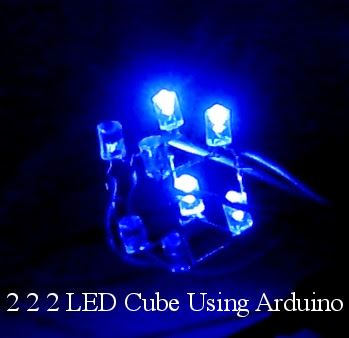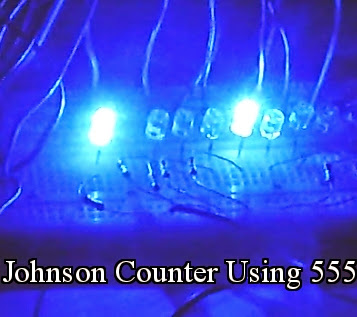Important : If there is any difficulty in the working of circuit, reduce the value of R2 and try the circuit again. Reduce the value in steps ( 1 MOhm, 10 KOhm, 1 Kohm, 0 Ohm ).
Astable mode operation of 555 is used to generate rectangular pulses of desired frequency. These rectangular pulses are normally used to give clock inputs to flip-flops and other digital systems. Following circuit demonstrates the astable mode operation of 555.
Important : If there is any difficulty in the working of circuit, reduce the value of R2 and try the circuit again. Reduce the value in steps ( 1 MOhm, 10 KOhm, 1 Kohm, 0 Ohm ).
Pinout diagram of 555
Pinout diagram of 555 is given below. Each 555 has eight pins arranged as shown in the following diagram.
Components required
555 Timer IC - 1
5V Voltage Source - Normally supplied from 5V regulator.
1KOhm Resistor - 1
10MOhm Resistor, R1 and R2 - 2
10nF Capacitor - 4
LED - 1
Push Button Switches, S1 and S2 - 2
In astable mode, 555 generates a continous stream of rectangular pulses having specified frequency. Frequency of generated signals depends on R1, R2 and C1. Resistor R1 is connected between VCC ( Pin 8 ) and discharge pin ( Pin 7 ) of 555. Resistor R2 is connected between discharge pin ( Pin 7 ) and threshold pin ( Pin 6 ) of 555. Threshold pin ( Pin 6 ) and trigger pin ( Pin 2 ) of 555 should be shorted. A capacitor bank is connected between trigger pin ( Pin 2 ) and ground pin ( Pin 1 ) of 555. Output is taken across the third pin of 555. A 10nF capacitor should be connected across CTRL pin ( Pin 5 ) and ground. RESET pin ( Pin 4 ) is connected to VCC ( Pin 8 ).
Capacitor bank has three 10nF capacitors connected in parallel. Two of these capacitors are controlled by two push button switches ( S1 and S2 ). When both switches are off, only one capacitor will be in circuit. Then C1 = 10nF. If S1 is pressed, one more capacitor will be included in the circuit. Then two 10nF capacitors will be in parallel. Net capacitance will be 20nF. If S2 is also pressed, other capacitor also get included in the circuit. Then three 10nF capacitors will come in parallel and the net capacitance will be 30nF.
Frequency of the rectangular pulses generated depends on the values of R1, R2 and C1.
Frequency, F = 1 / ( ln( 2 ) . C1 . ( R1+2R2 ) )
Ton = ln( 2 ) . C1 . ( R1 + R2 )
Toff = ln( 2 ) . C1 . R2
C1- Capacitance in Farad, R1 and R2 - Resistance in Ohms, F - Frequency in Hertz, Ton - Time for which output will be HIGH ( LED will be ON ), Toff - Time for which output will be LOW ( LED will be OFF )
When S1 and S2 are OFF
Only one capacitor will be included in the circuit. Then
C1 = 10 nano Farad = 0.01 micro Farad = 0.01 * 10-6 Farad
R1 = R2 = 10 Mega Ohm = 10 * 106 Ohm
ln ( 2 ) = 0.693
Substituting these values in the equations, we get
F = 4.81 Hz, Ton = 0.1386 S, Toff = 0.0693 S
When S1 is OFF and S2 is ON
Two capacitors will be in parallel in the circuit. Then
C1 = 10 + 10 nano Farad = 20 nano Farad = 0.02 micro Farad = 0.02 * 10-6 Farad
R1 = R2 = 10 Mega Ohm = 10 * 106 Ohm
ln ( 2 ) = 0.693
Substituting these values in the equations, we get
F = 2.405 Hz, Ton = 0.2772 S, Toff = 0.1386 S
When S1 and S2 are ON
Three capacitors will be in parallel in the circuit. Then
C1 = 10 + 10 + 10 nano Farad = 30 nano Farad = 0.03 micro Farad = 0.03 * 10-6 Farad
R1 = R2 = 10 Mega Ohm = 10 * 106 Ohm
ln ( 2 ) = 0.693
Substituting these values in the equations, we get
F = 1.603 Hz, Ton = 0.4158 S, Toff = 0.2079 S
From the calculations, we can conclude that, when the value of capacitance increases, speed of LED blinking decreases as shown in the animated image.
Astable mode operation of 555 is used to generate rectangular pulses of desired frequency. These rectangular pulses are normally used to give clock inputs to flip-flops and other digital systems. Following circuit demonstrates the astable mode operation of 555.
Important : If there is any difficulty in the working of circuit, reduce the value of R2 and try the circuit again. Reduce the value in steps ( 1 MOhm, 10 KOhm, 1 Kohm, 0 Ohm ).
Pinout diagram of 555
Pinout diagram of 555 is given below. Each 555 has eight pins arranged as shown in the following diagram.
Components required
555 Timer IC - 1
5V Voltage Source - Normally supplied from 5V regulator.
1KOhm Resistor - 1
10MOhm Resistor, R1 and R2 - 2
10nF Capacitor - 4
LED - 1
Push Button Switches, S1 and S2 - 2
In astable mode, 555 generates a continous stream of rectangular pulses having specified frequency. Frequency of generated signals depends on R1, R2 and C1. Resistor R1 is connected between VCC ( Pin 8 ) and discharge pin ( Pin 7 ) of 555. Resistor R2 is connected between discharge pin ( Pin 7 ) and threshold pin ( Pin 6 ) of 555. Threshold pin ( Pin 6 ) and trigger pin ( Pin 2 ) of 555 should be shorted. A capacitor bank is connected between trigger pin ( Pin 2 ) and ground pin ( Pin 1 ) of 555. Output is taken across the third pin of 555. A 10nF capacitor should be connected across CTRL pin ( Pin 5 ) and ground. RESET pin ( Pin 4 ) is connected to VCC ( Pin 8 ).
Capacitor bank has three 10nF capacitors connected in parallel. Two of these capacitors are controlled by two push button switches ( S1 and S2 ). When both switches are off, only one capacitor will be in circuit. Then C1 = 10nF. If S1 is pressed, one more capacitor will be included in the circuit. Then two 10nF capacitors will be in parallel. Net capacitance will be 20nF. If S2 is also pressed, other capacitor also get included in the circuit. Then three 10nF capacitors will come in parallel and the net capacitance will be 30nF.
Frequency of the rectangular pulses generated depends on the values of R1, R2 and C1.
Frequency, F = 1 / ( ln( 2 ) . C1 . ( R1+2R2 ) )
Ton = ln( 2 ) . C1 . ( R1 + R2 )
Toff = ln( 2 ) . C1 . R2
C1- Capacitance in Farad, R1 and R2 - Resistance in Ohms, F - Frequency in Hertz, Ton - Time for which output will be HIGH ( LED will be ON ), Toff - Time for which output will be LOW ( LED will be OFF )
When S1 and S2 are OFF
Only one capacitor will be included in the circuit. Then
C1 = 10 nano Farad = 0.01 micro Farad = 0.01 * 10-6 Farad
R1 = R2 = 10 Mega Ohm = 10 * 106 Ohm
ln ( 2 ) = 0.693
Substituting these values in the equations, we get
F = 4.81 Hz, Ton = 0.1386 S, Toff = 0.0693 S
When S1 is OFF and S2 is ON
Two capacitors will be in parallel in the circuit. Then
C1 = 10 + 10 nano Farad = 20 nano Farad = 0.02 micro Farad = 0.02 * 10-6 Farad
R1 = R2 = 10 Mega Ohm = 10 * 106 Ohm
ln ( 2 ) = 0.693
Substituting these values in the equations, we get
F = 2.405 Hz, Ton = 0.2772 S, Toff = 0.1386 S
When S1 and S2 are ON
Three capacitors will be in parallel in the circuit. Then
C1 = 10 + 10 + 10 nano Farad = 30 nano Farad = 0.03 micro Farad = 0.03 * 10-6 Farad
R1 = R2 = 10 Mega Ohm = 10 * 106 Ohm
ln ( 2 ) = 0.693
Substituting these values in the equations, we get
F = 1.603 Hz, Ton = 0.4158 S, Toff = 0.2079 S
From the calculations, we can conclude that, when the value of capacitance increases, speed of LED blinking decreases as shown in the animated image.








0 comments: